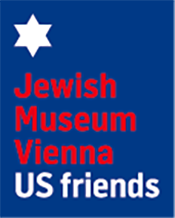“Hanukkah” and “Berger”
Dec 21, 2020 | JMW News
This form of Hanukkah menorah is called the bench-style type. The technical terms from the silversmith’s workshop describe the menorah as wrought, engraved, chased and textured. The object is 22.5 cm high, 27.5 cm wide and, at 652 grams, relatively light.
The workmaster’s mark indicates Emanuel Goldberger as the silversmith who registered his workshop at Auhofstraße 13 in 1886. The stamped hallmark shows the head of Diana with a crescent moon and the letter A for Vienna. Acanthus leaves, lilies and other leafage and flowers with their architectural form elements point towards the Neo-Gothic style that can also be found in the Laxenburg Palace or the Vienna City Hall.
Two Tablets of the Law are featured in the center, flanked by two rampant lions with forked tails. This kind of lion was part of the Bohemian coat of arms. The exact route from the client via the artist to a household in which the menorah was used during the Hanukkah festival can no longer be traced. The object was dated directly to the Habsburg Monarchy period and the particular anatomy of the lions on the menorah makes it clear that religion and patriotism can enter into a dialogue.
You can get a closer look at the hanukkiah here
The shamash can be seen at the top right, with whose flame—the hanukkiah (menorah) is lit using oil and wicks—the eight oil burners placed below are ignited. Underneath them is a transversely rectangular drip tray that stands on four curved feet. The hanging loop attached to the back, which enables the menorah to be attached to a wall, is not visible.
This object is part of the Max Berger Collection, which was acquired in 1986 on the occasion of the re-establishment of the Jewish Museum Vienna. Max Berger, born in 1926, was the only member in his family who had survived the Shoah and ended up stranded in Vienna in 1945 as a Displaced Person. He stayed here, built up a furniture company, attained prosperity and assembled a quite large Judaica collection, which he exhibited in his apartment and presented to his guests. It is not known why Max Berger added precisely this menorah to his collection. The Jewish Museum Vienna Collection only contains this work by Emanuel Goldberger.
If you enter the combination of the terms “Hanukkah” and “Berger” into the search mask of the museum inventory, you get 116 hits. These include menorahs, the beloved Hanukkah dreidel toy, as well as a portrait of Theodor Herzl from 1930 by Wilhelm Wachtel, who painted it from photographic templates. The artist gave it to the “Herzl Club” as a Hanukkah gift. It cannot be determined which club received it. Such organizations were founded in connection with the strengthening of the Zionist movement in many Austrian and German cities.

Image © JMW
In December 1895, Theodor Herzl had a decorated tree in his apartment when Rabbi Güdemann came to visit. Both gentlemen made notes about this encounter in their diaries:
“I was just lighting the Christmas tree for my children when Güdemann arrived. He seemed upset by the ‘Christian’ custom. Well, I will not let myself be pressured! But I don’t mind if they call it the Hanukkah tree—or the winter solstice.”
“So on December 24th I went to see him at Pelikangasse, number 16 I believe, where he lived. I was let into a large drawing room and found there—imagine my surprise—a huge Christmas tree. Soon Herzl entered […]. Our conversation—in the presence of the Christmas tree—was rather cumbersome and I soon took my leave.”
(from “‘Solls der Chanukkabaum heißen’. Chanukka, Weihnachten, Weihnukka,“ Berlin: Verlag Das Arsenal, p. 8)
Cover image © JMW
